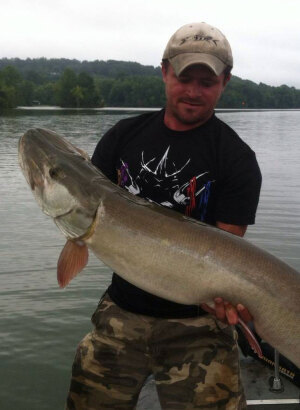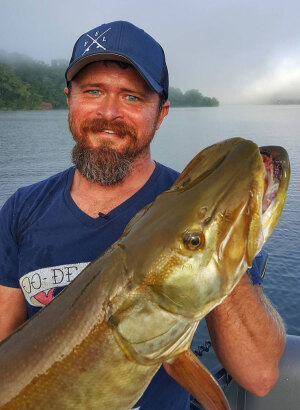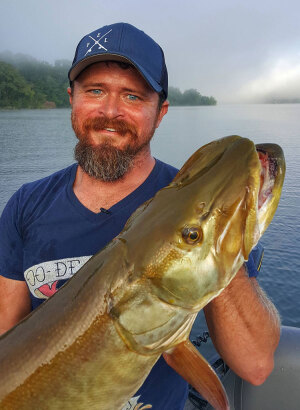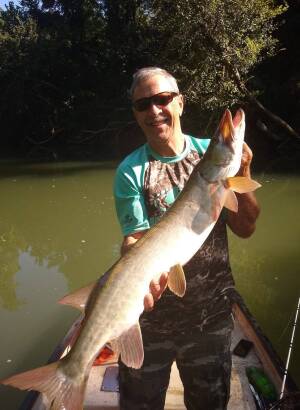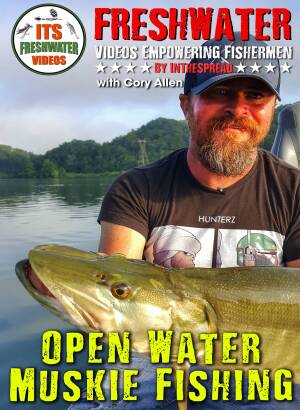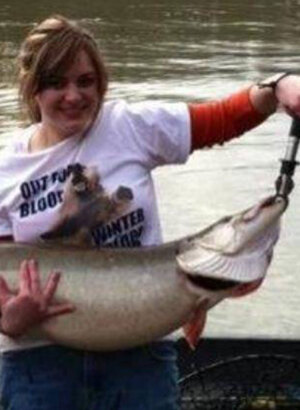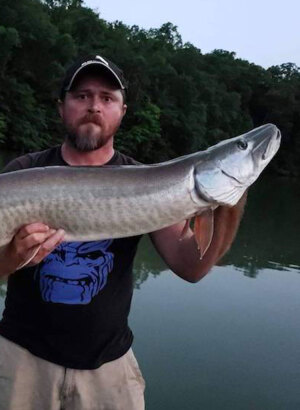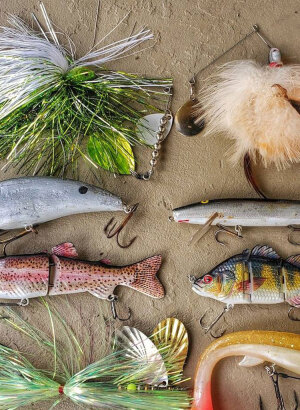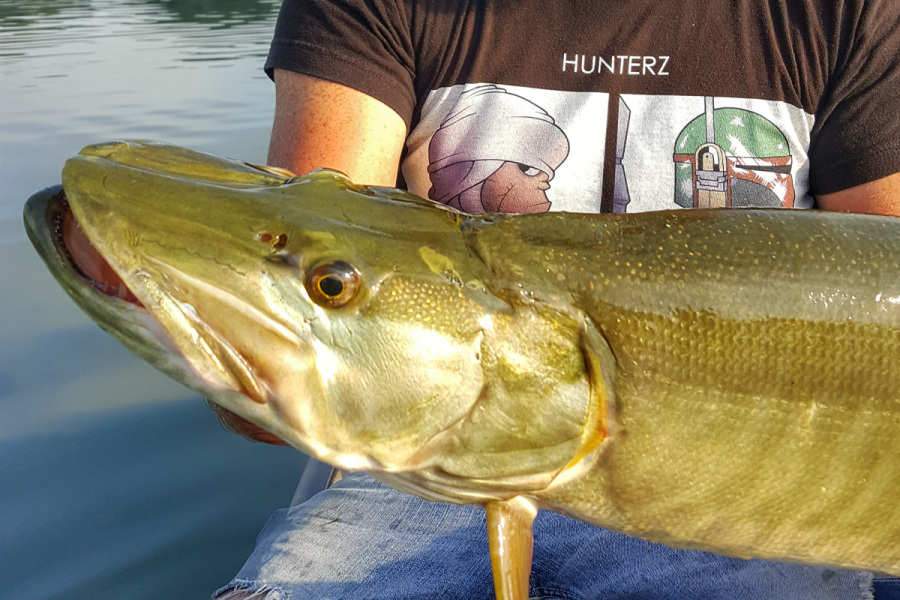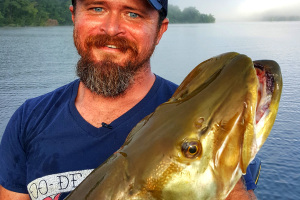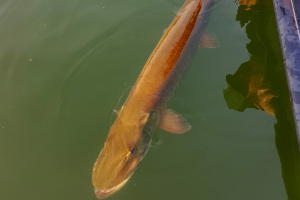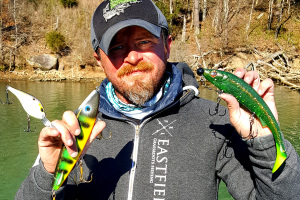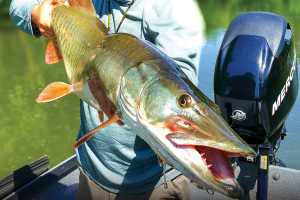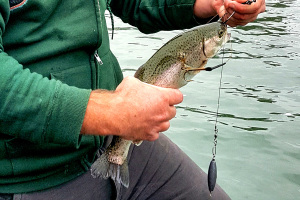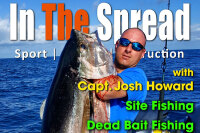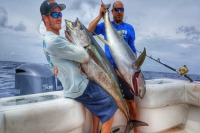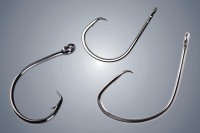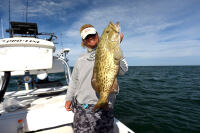A musky, a large predatory fish native to North America, is a member of the pike family and is known for its slender body and sharp scales. Found in cold lakes and streams, they are aggressive predators that feed on other fish, birds, and small mammals. Muskie are apex predators, controlling prey populations and maintaining ecosystem balance. They are highly sought after by anglers.
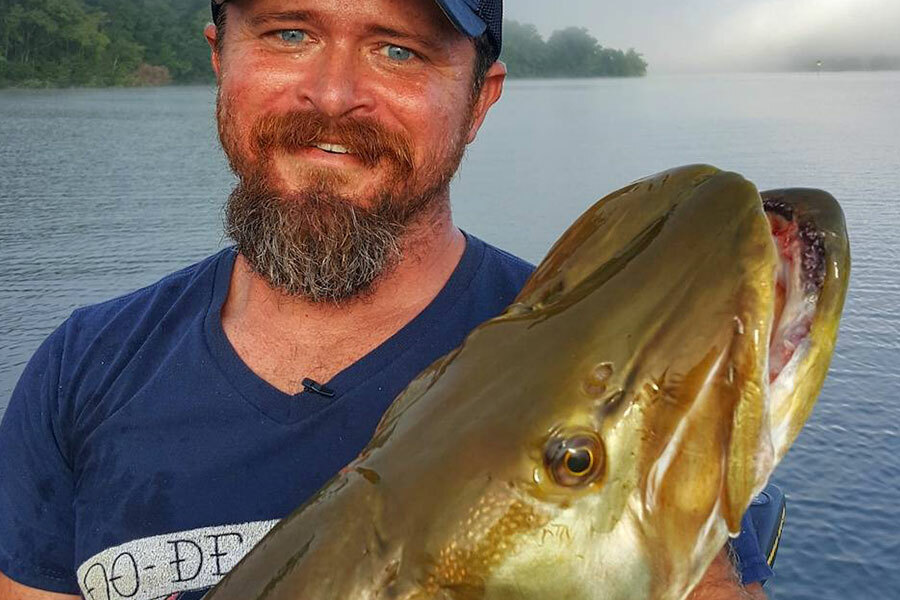
Musky - Catch This Apex Predator
A musky (aka muskellunge or muskie) is a large, predatory fish that is native to North America. It is a member of the pike family and is known for its long, slender body and sharp, tooth-like scales. Muskellunge are typically found in cold, clear lakes and streams, and they are known to be aggressive predators that feed on other fish, as well as birds and small mammals. The musky is a popular game fish and are highly sought after by anglers due to their size and fighting ability. They are known to put up a strong fight when caught and can grow to be quite large, with some individuals reaching lengths of over 50 inches and weights of up to 50 pounds.
Muskellunge belong to the taxonomic family Esocidae, which includes the pike family. The scientific name for the muskellunge is Esox masquinongy, and it is the largest member of the pike family.
Here is the taxonomy for the muskellunge:
- Kingdom: Animalia
- Phylum: ChordataClass: Actinopterygii (ray-finned fishes)
- Order: Esociformes (pike-like fishes)
- Family: Esocidae (pike family)
- Genus: Esox
- Species: E. masquinongy (muskellunge)
Musky fish are native to North America and are found in lakes and streams throughout much of the continent. They are known for their long, slender bodies and sharp, tooth-like scales, and they are popular game fish due to their size and fighting ability. Muskie are apex predators in the ecosystems in which they are found and play important roles in maintaining the balance of the ecosystem by controlling the populations of their prey.
Apex Predators
Musky are the apex predator in the ecosystems in which it is found. An apex predator is a predator that sits at the top of the food chain and has no natural predators of its own. Muskellunge are top predators in the lakes and streams where they are found, and they play an important role in maintaining the balance of the ecosystem by controlling the populations of their prey. Muskellunge are known to feed on a variety of other fish, as well as birds and small mammals, and they are capable of taking down large prey due to their size and strength. In addition to their role as predators, muskellunge also play important roles as prey for other species, such as bears and wolves, and as indicators of the overall health of the ecosystem.
Muskie Habitat
Muskies are typically found in clear, cool lakes and streams with rocky or gravelly bottoms and plenty of aquatic vegetation. They are often found in areas with good water circulation and plenty of cover, such as logs, rocks, or submerged trees.
Muskies are known for their preference for deep, cool waters, and they are often found in depths ranging from 20 to 40 feet. In some areas, they may be found in shallower waters, especially during the warmer months.
Muskies are found in a wide range of habitats, including large lakes, small ponds, and fast-flowing streams. They are often found near the mouths of rivers and streams, where they can access a wide range of prey. Musky populations can also be found in areas with a variety of vegetation types, including cattails, bulrushes, and lily pads.
Muskies are highly adaptable fish, and they are capable of surviving in a wide range of environmental conditions. They are well-suited to living in colder, northern climates, and they are found in many states and provinces throughout the United States and Canada.
The Musky Diet
Muskie feed on a variety of other animals. In the wild, muskies are known to feed on other fish, such as perch, bass, and panfish, as well as small mammals, birds, and even reptiles. Muskies are known to be opportunistic feeders and will take whatever prey is most readily available to them. They are also known to feed on large prey, such as ducks, and have even been known to attack humans in rare instances. Muskellunge are typically found in cold, clear lakes and streams, and they prefer to ambush their prey from cover, using their size and strength to overpower their prey.
Muskie Fishing Videos
In The Spread fishing videos offer you tools to level up your musky fishing skills. This is not an easy fish to catch, so the more you know, the better off you will be. With our videos, we try to work with fishermen of the highest order, so you have the opportunity to learn from their depth of experience and wisdom. To learn more about specific tactics and techniques, tackle, line, leader material, rods, reels, rigs and to gain a wealth of knowledge from some of the world's finest fishermen, browse our library of Muskie Fishing Videos
Video Instruction on How to Catch Musky
Topography and Fishing
Known to be highly sensitive to changes in the environment, musky can be strongly influenced by the topography of the area in which they are found.
Musky are known to prefer certain types of habitat, such as weed beds, rock piles, and sunken wood, and they will often hold in these areas as they wait for prey to come by. The presence of these types of structures can be influenced by the topography of the area, with lakes and streams that have a lot of rocks, cliffs, or other features tending to have more of these types of habitat.
The Esox are also known to be influenced by water temperature and flow, both of which can be affected by topography. Lakes and streams with steep gradients and large changes in elevation tend to have more dramatic changes in water temperature and flow, which can be attractive to musky.
Overall, the topography of an area can have a significant impact on the distribution and behavior of musky, and anglers often consider topographic features when selecting a fishing spot or planning a fishing trip.
The Fish of 10,000 Casts
It may sound cliche', but damn if it's not true. The muskellunge can be very difficult to catch, even for experienced anglers. Musky are known to be highly selective feeders and are often very wary of lures and baits, making them challenging to entice into biting. They are also known to be strong and powerful fighters when hooked, and they can put up a long and grueling fight before being landed.
The nickname "fish of 10,000 casts" is often used to reflect the challenge and perseverance that is required to catch a musky, as well as the time and effort that is often needed to locate and target these elusive fish. Musky fishing can be very rewarding for those who are able to catch one, but it can also be very frustrating for those who are unable to do so, even after many attempts.
Despite the challenges that are associated with musky fishing, these fish are highly prized by anglers due to their size and fighting ability, and many anglers are willing to put in the time and effort required to catch one. Musky fishing has become increasingly popular in recent years, and there are many resources available to help anglers learn how to target and catch these elusive fish.
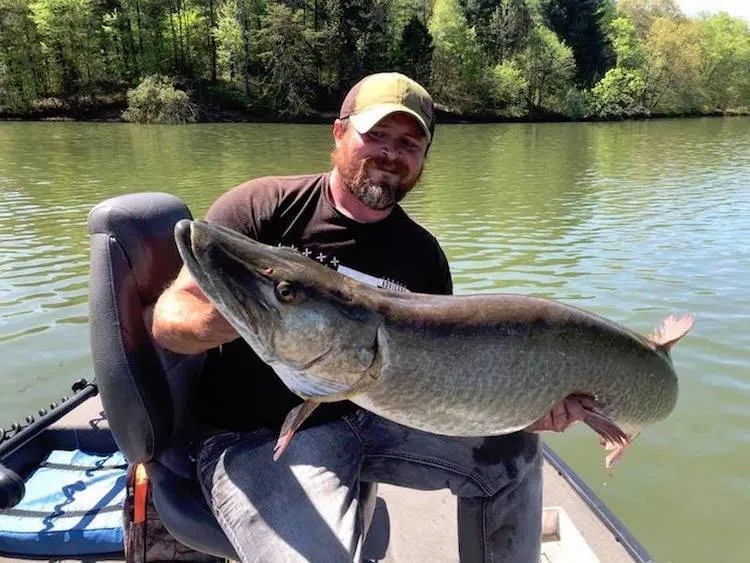
Fishing for Muskie
Anglers typically fish for musky using a variety of techniques, depending on the time of year, the weather, and the local conditions. Some common techniques for musky fishing include trolling, casting, and jigging.
- Trolling is a technique in which the angler moves the boat slowly through the water while using one or more fishing lines to cover a large area. Musky will often follow a bait or lure before striking, so trolling can be an effective way to cover a lot of water and locate fish.
- Casting is a technique in which the angler uses a rod and reel to cast a bait or lure out into the water and retrieve it slowly. This can be done from the shore or from a boat, and it is often used to cover a specific area or to target specific structures in the water.
- Jigging is a technique in which the angler uses a heavy, jig-shaped bait to mimic the movement of a small fish or other prey. The jig is dropped down to the desired depth and then worked up and down in a jerking motion to mimic the movements of a wounded or struggling fish.
Regardless of the technique used, musky fishing typically requires the use of heavy tackle, as these fish are known to put up a strong fight when hooked. Musky are also highly sensitive to the type of bait or lure used, and anglers often use a variety of different lures and presentations to try to entice a bite.

Trolling for Musky
Trolling is a common technique used for musky fishing, and it involves slowly dragging a lure or bait behind a boat as it moves through the water. There are a few key tactics to consider when trolling for muskies:
- Speed: The speed at which you troll can be an important factor in attracting muskies. In general, muskies prefer slower trolling speeds, and many anglers find that speeds of 2-3 mph are effective.
- Depth: Muskies are often found at different depths depending on the time of year and the water temperature. In the warmer months, muskies may be found in shallower water, while in the cooler months, they may be found at greater depths. It can be helpful to use a depth finder or other device to determine the depth at which muskies are likely to be found and to adjust your trolling depth accordingly.
- Lures: There are a wide variety of lures that can be effective for musky fishing, including crankbaits, spinnerbaits, and topwater lures. It can be helpful to experiment with different lures and retrieve speeds to find what works best in a given situation.
- Cover: Muskies are often found around structures such as rocks, logs, and submerged trees, and trolling near these types of cover can be an effective way to target them.
- Location: Muskies are often found near the mouths of rivers and streams, where they can access a wide range of prey. Trolling in these areas can be an effective way to target muskies.
Overall, trolling for musky can be an effective technique, and it can be a great way to cover a lot of water and locate concentrations of muskies. By adjusting your trolling speed, depth, lure selection, and location, you can increase your chances of success when targeting muskies.
Jigging for Musky
Jigging for musky is a technique in which the angler uses a heavy, jig-shaped bait to mimic the movement of a small fish or other prey. The jig is dropped down to the desired depth and then worked up and down in a jerking motion to mimic the movements of a wounded or struggling fish.
To jig for musky, anglers typically use a rod with a fast action and a reel with a high gear ratio, as well as braided or fluorocarbon line with a high breaking strength. The jig itself is usually made of metal or a heavy, durable plastic, and it is typically weighted to help it sink to the desired depth. Some anglers also use a trailer, such as a soft plastic bait or a feather, to add additional movement and attraction to the jig.
To jig for musky, the angler will typically start by casting the jig out into the water and allowing it to sink to the desired depth. The jig is then worked up and down in a jerking motion, with the angler pausing for a few seconds between jerks to allow the jig to sink back down. This technique is designed to mimic the movements of a wounded or struggling fish and can be effective at attracting the attention of predatory musky.
Jigging for musky can be done from a boat or from the shore, and it is often effective in areas with structural features such as weeds, rocks, or sunken wood. Musky are known to be highly sensitive to the type of bait or lure used, so anglers often experiment with different colors, patterns, and sizes of jigs to find what works best in a given situation.
Fast or Slow on the Lure Retrieve
The speed at which a fishing lure is retrieved can be an important factor in determining its effectiveness for musky fishing. This really is a highly variable aspect of your fishing. Certain lures are designed to perform best at a given speed, so understanding this is critical to achieve the right swimming action.
Muskie as predators are highly selective feeders and can be very wary of lures and baits. As a result, the speed at which a lure is retrieved can be an important factor in attracting the attention of these fish and getting them to bite.
In general, it is often best to retrieve a fishing lure slowly when targeting musky, as this allows the lure to mimic the movements of a wounded or struggling prey animal, which can be more attractive to predatory fish. Slow retrieves also allow the angler to cover more water and explore a larger area, which can be helpful for locating and targeting musky.
However, it is also important to vary the speed of the retrieve and to experiment with different speeds to see what works best in a given situation. Musky are known to be highly sensitive to the type of bait or lure used and may respond differently to different retrieves. Some anglers will also use a combination of fast and slow retrieves, or will pause the retrieve briefly to allow the lure to sink and then resume retrieving it slowly. This can be an effective way to trigger a bite from a musky that may be hesitant to bite a lure that is being retrieved too quickly.
Learn new fishing skills or build upon your knowledge foundation with our powerful learning system. Our instructional fishing videos are geared to help you in all sorts of situations and conditions. We work with the best fishermen, so you get the best information.

